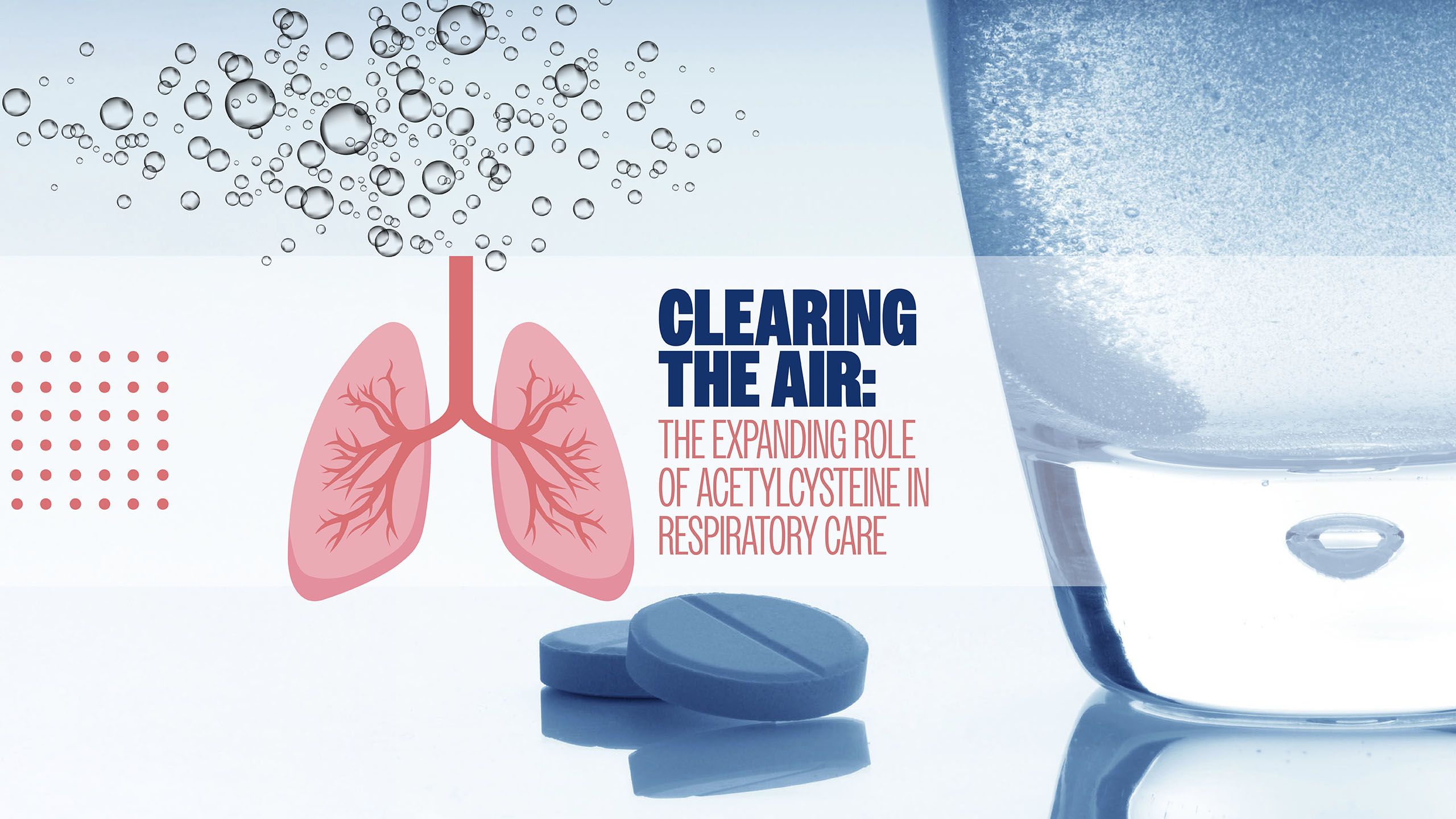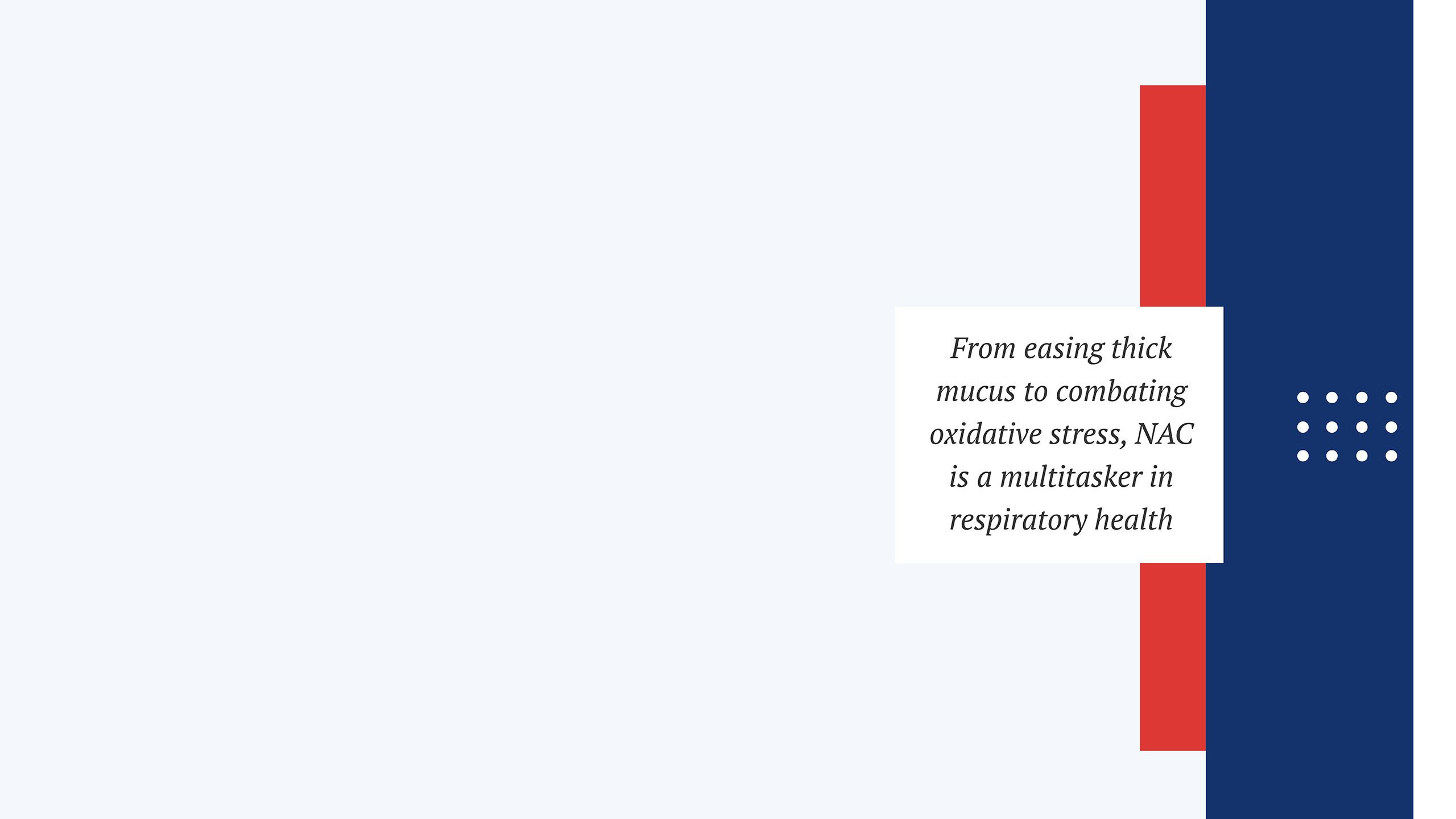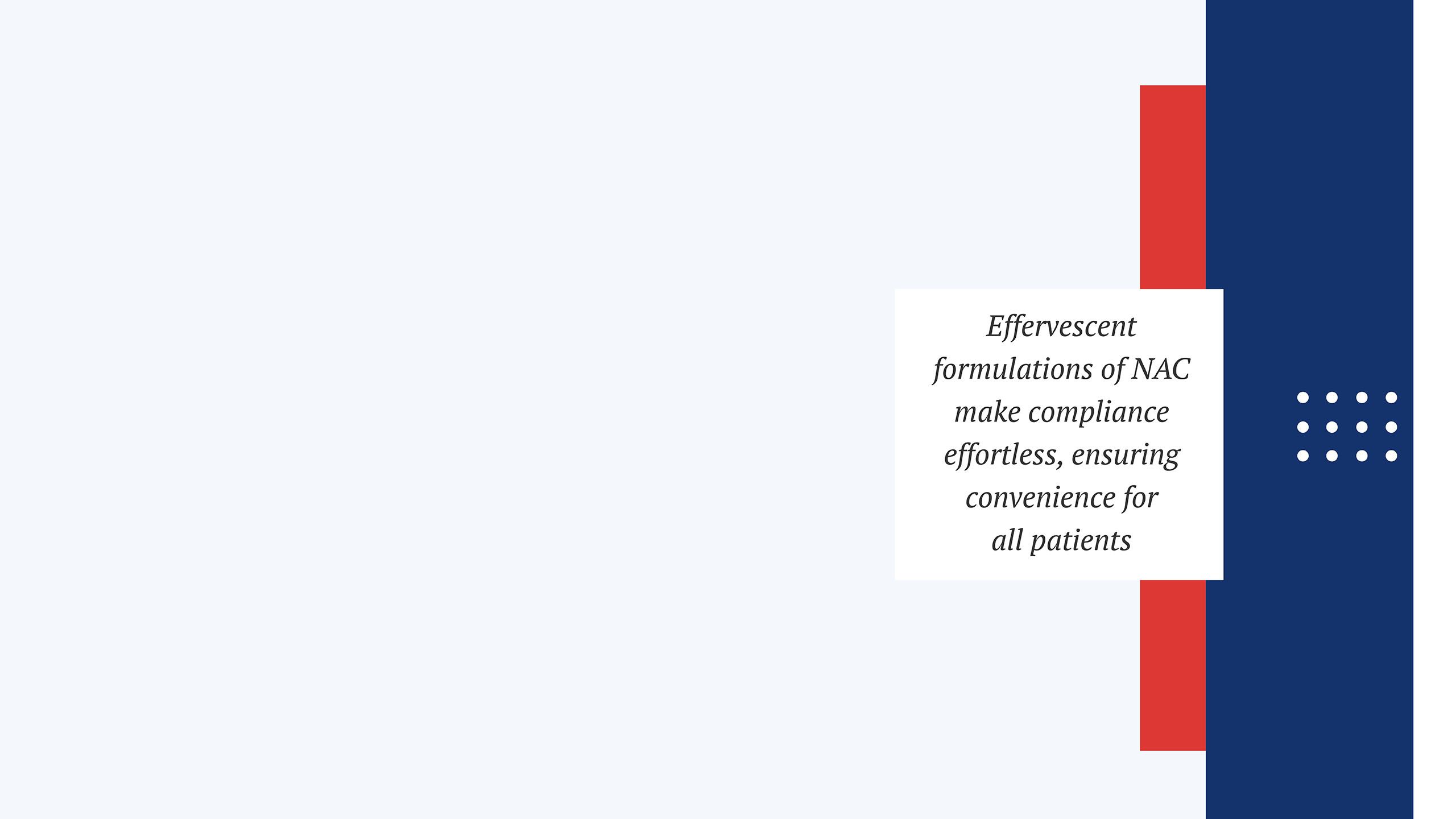
Acetylcysteine, commonly known as N-acetylcysteine (NAC), is an essential therapeutic agent in respiratory care. Its versatility as a mucolytic agent, antioxidant, and adjunct in various respiratory conditions underscores its importance in both acute and chronic management protocols.1 Pharmacists, as key healthcare practitioners, play a pivotal role in optimising its use across diverse patient profiles.


ACUTE AND CHRONIC APPLICATIONS: TWO SIDES OF THE SAME COIN
Acetylcysteine has dual applications in respiratory care, addressing short-lived complications and ongoing conditions2:
- Acute use: NAC may serve as an adjunct therapy in the immediate management of conditions requiring rapid mucus clearance, especially in acute situations where thick secretions compromise oxygen exchange. For example, its mucolytic action enables reduced sputum viscosity, facilitating mucociliary clearance and improving airway function. This is particularly seen in acute exacerbations of chronic respiratory diseases like COPD, where mucus removal is critical. It’s potential use in acute cases like pneumonia has also been noted.3
- Chronic use: NAC is extensively utilised in the long-term management of chronic respiratory diseases, including cystic fibrosis, maintenance therapy for COPD, and chronic bronchitis. Its applications go beyond mucus dissolution; NAC's antioxidant properties help replenish intracellular glutathione (GSH), mitigating oxidative stress and reducing chronic airway inflammation. These effects play a critical role in potentially slowing disease progression and improving quality of life for patients suffering from recurrent airway obstruction or chronic cough. Evidence highlights its ability to maintain lung function, alleviate symptoms, and diminish exacerbations, making it an integral component of chronic disease protocols.2,3
THE EFFICACY OF LOW-DOSE ACETYLCYSTEINE AS A MUCOLYTIC
NAC demonstrates well-recognised mucolytic properties across various respiratory conditions by targeting mucus viscosity reduction. While higher doses are commonly prescribed for significant therapeutic outcomes, lower doses, such as 200 mg, may provide benefits in mild to moderate cases due to NAC's established mechanism of action. NAC’s hydrolyses disulfide bonds in mucin glycoproteins through its sulfhydryl groups, which reduces mucus thickness and enhances secretion clearance.3,4,5
Evidence on NAC for conditions like chronic bronchitis, COPD, and non-cystic fibrosis bronchiectasis validates its mucolytic role.3,4,5
When paired with bronchodilator therapies, NAC may provide complementary benefits, particularly in enhancing mucus clearance and relieving symptoms such as coughing and sputum production.5,6



DOSING CONVENIENCE: THE ROLE OF EFFERVESCENT FORMATS
Compliance often dictates therapeutic success, and dosing convenience is vital, especially in chronic conditions requiring long-term adherence. Effervescent formulations of NAC have garnered attention due to their user-friendly nature. These are pre-formulated into easily dissolvable fizzy tablets or powders, ensuring rapid preparation and improved palatability compared to traditional liquid solutions or inhalers.7
For pharmacists, recommending effervescent formulations can ease patient compliance, whether for bedridden individuals, the elderly, or those in outpatient settings. Additionally, these formats ensure uniform dosing, dissolving evenly with fewer chances for error, meeting stringent accuracy requirements in pharmaceutical care.7
TAILORING THERAPY TO SPECIFIC PATIENT PROFILES
Pharmacists are instrumental in identifying the right patient profiles for NAC therapy:
- Elderly patients: NAC is ideal for older patients battling chronic conditions with impaired mucociliary clearance, offering benefits without significant contraindications.8
- Children from two years old with cystic fibrosis: Paediatric patients may benefit from carefully monitored dosing to manage thick pulmonary secretions, administered as part of a broader care protocol.9
- Smokers or ex-smokers: NAC aids individuals in clearing the excess mucus resulting from smoking-induced bronchial irritation or chronic lung conditions.2
- Immunocompromised populations: With its antioxidant properties, NAC supports respiratory immunity, playing a supportive role in these vulnerable populations.10
- By considering symptoms, accompanying diseases, and patient compliance risks, pharmacists can recommend NAC therapy in alignment with approved dosing guidelines to ensure efficacy while supporting a positive patient experience.
CONCLUSION: A CORNERSTONE OF RESPIRATORY CARE
NAC continues to carve its niche as a cornerstone in respiratory treatment. From providing immediate relief in acute respiratory emergencies to supporting chronic disease management, it acts through well-established mechanisms as a mucolytic. By leveraging formulations like 200 mg effervescent doses and targeting therapy to suitable patient profiles, pharmacists can aid in optimising respiratory therapy outcomes.11
Pharmacists stand at the forefront of enabling better respiratory health. By incorporating knowledge of NAC’s expanding applications into their practice, they can substantially elevate patient care quality, truly helping to ‘clear the air’ for those in need.
REFERENCES
- Sadowska AM. N-Acetylcysteine mucolysis in the management of chronic obstructive pulmonary disease. Therapeutic Advances in Respiratory Disease. 2012;6(3):127-135. Available from: https://journals.sagepub.com/doi/10.1177/1753465812437563?icid=int.sj-full-text.similar-articles.2
- Mokra D, Mokry J, Barosova R, et al. Advances in the Use of N-Acetylcysteine in Chronic Respiratory Diseases. Antioxidants (Basel). 2023 Sep 2;12(9):1713. Available from: https://pmc.ncbi.nlm.nih.gov/articles/PMC10526097/.
- Luo A, Liu X, Hu Q, et al. Efficacy of N-acetylcysteine on idiopathic or postinfective non-cystic fibrosis bronchiectasis: a systematic review and meta-analysis protocol. BMJ Open 2022;12:e053625. Available from: https://bmjopen.bmj.com/content/12/3/e053625.
- Banerjee S, McCormack S. Acetylcysteine for Patients Requiring Mucous Secretion Clearance: A Review of Clinical Effectiveness and Safety [Internet]. Ottawa (ON): Canadian Agency for Drugs and Technologies in Health; 2019 Jun 14. Available from: https://www.ncbi.nlm.nih.gov/books/NBK546019/.
- Huang C, Kuo S, Lin L, Yang Y. The efficacy of N-acetylcysteine in chronic obstructive pulmonary disease patients: a meta-analysis. Ther Adv Respir Dis. 2023 Jan-Dec;17:17534666231158563. Available from https://pmc.ncbi.nlm.nih.gov/articles/PMC10026096/.
- Donohue JF. Combination Therapy for Chronic Obstructive Pulmonary Disease
- Clinical Aspects. Proceeding of the American Thoracic Society. 2005 July 13;2(4). Available from: https://www.atsjournals.org/doi/10.1513/pats.200505-047SR.
- DrugBank Online Staff. Acetylcysteine. DrugBank Online. Available from: https://go.drugbank.com/drugs/DB06151.
- Tardiolo G, Bramanti P, Mazzon E. Overview on the Effects of N-Acetylcysteine in Neurodegenerative Diseases. Molecules. 2018 Dec 13;23(12):3305. Available from: http://pmc.ncbi.nlm.nih.gov/articles/PMC6320789/.
- Guerini M, Condrò G, Friuli V, Maggi L, Perugini P. N-acetylcysteine (NAC) and Its Role in Clinical Practice Management of Cystic Fibrosis (CF): A Review. Pharmaceuticals (Basel). 2022 Feb 11;15(2):217. Available from: https://pmc.ncbi.nlm.nih.gov/articles/PMC8879903/.
- Izquierdo-Alonso JL, Pérez-Rial S, Rivera CG, Peces-Barba G. N-acetylcysteine for prevention and treatment of COVID-19: Current state of evidence and future directions. J Infect Public Health. 2022 Dec;15(12):1477-1483. Available from: https://pmc.ncbi.nlm.nih.gov/articles/PMC9651994/.
- MedlinePlus staff. Acetylcysteine. MedlinePlus. 2017 March 15. Available from: https://medlineplus.gov/druginfo/meds/a615021.html.
Image Credit: Getty Images



